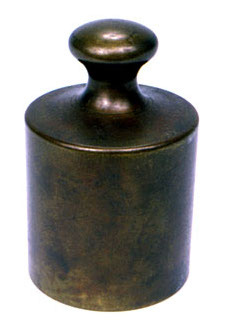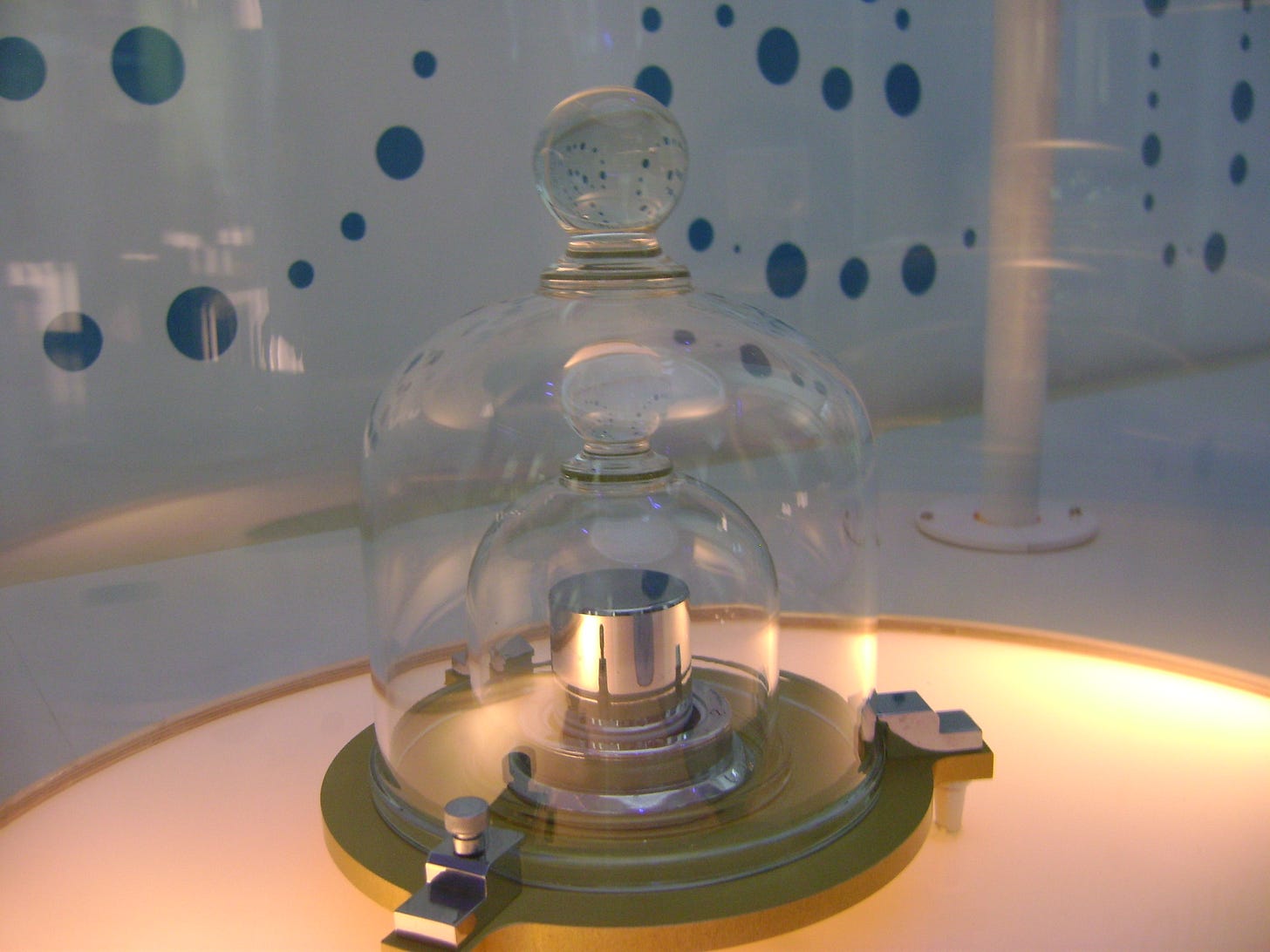(#2) 200 years later Mass finally found its value
We don't need no French control, no IPK in the BIPM, Planck give us the absolute mass...
Everything that we know today about the entire known universe can be measured in units which can ultimately be expressed in below mentioned 7 fundamental units:
Kilogram, kg (mass)
Meter, m (distance)
Second, s (time)
Kelvin, K (temp)
Ampere, A (electric current)
Candela, cd (luminous intensity)
Mole, mol (quantity)
image source: wikipediaSpecial thing about above 7 fundamental units is that all of these units are derived from a combination of some ‘universal’ constants which will remain true for the entire universe until eternity.
This is not how it all started though.
French were supposedly the first ones who recognized the need to have a universal measure system.
The success of the French attempt to create a universal system of units of measurement was due to several reasons. But perhaps the main reason that forced rulers to be so determined was the special chaotic situation of units of measurement there at that time, where about 800 different names for measures have been estimated, whose units varied in different towns, for a total of about 250000 differently sized units.
“It is quite evident that the diversity of weights and measures of different countries, and frequently in the same province, are a source of embarrassment in commerce, in the study of physics, in history, and even in politics itself; the unknown names of foreign measures, the laziness or difficulty in relating them to our own give rise to confusion in our ideas and leave us in ignorance of facts which could be useful to us'', complains Charles de La Condamine .
All fundamental units were initially pegged / referenced to some, occasionally physical, human artifacts (anthropomorphic units) before a need was felt to re-define them more precisely independent of (physical or otherwise) chosen artifacts.
Second, Kelvin, Candela, Meter, Mass, Mole and Ampere - all started as some sort of physically derived units before we were able to re-define them through universal constants.
Mass is the last unit that found its value through universal constants. Before we get down to Mass - let me jog your memory on other units:
Second (time)
In the 1940s, 1 second was defined as 1/86,400 the time it takes the Earth to rotate once (86,400 is number of seconds in a 24 hr day)
By 1940’s it became apparent that Earth's orbit around the Sun (a year) was much more stable than Earth's rotation. This led to proposals as early as 1950 to define the second as a fraction of a year.
In the 1950s, the second was redefined as 1/31,556,925.9747 the time it takes the Earth to orbit the sun.
Finally, in the 1960s, technology advanced enough to redefine the second not from an artifact (like the Earth) but from a fundamental property of the universe.
Today the second is defined as the time it takes an electron in a Cesium-133 atom to oscillate 9,192,631,770 times.
And since we have good reason to believe that electrons are constant properties of our universe, this definition is good everywhere and for all eternity.
Meter (length)
The meter had a similarly long and remarkable journey.
Defined first as 1/10,000,000 of the distance from the equator to the north pole, then as the distance between two marks on a platinum-iridium bar in France.
In 1960, meter was defined as equal to 1,650,763.73 wavelengths of the orange-red emission line in the electromagnetic spectrum of the Krypton-86 atom in a vacuum. And thus 1960 marked the delineation of the definition of Meter from a physical artifact (platinum-iridium bar in France).
To further reduce uncertainty, the meter was redefined in 1980s. Meter finally left artifact based definitions behind in the 1980's when timing equipment was precise enough that the meter could be defined as the distance light travels in a vacuum in 1/299,792,458 of a second.
And since we have good reason to believe the speed of light is a constant property of our universe (read more about the constancy of speed of light in my post here), this definition of the meter is good everywhere and for all eternity
Kelvin (temperature)
Earlier Kelvin was defined by the temperature of the triple point of water - the temperature (0.01°C or 273.15) at which water exist in solid, liquid and gaseous phases.
In 2018, the value of Kelvin was defined by the Boltzmann constant k (1.380 649×10^(–23) J / K), which links temperature to a particles’ kinetic energy.
After the redefinition, water will freeze at 273.15 K (0 °C).
The difference is that, before the redefinition, the triple point of water was exact and the Boltzmann constant had a measured value of 1.38064903 × 10^−23 J / K, with a standard uncertainty of 3.7×10^−7. Afterward, the Boltzmann constant is exact and the uncertainty is transferred to the triple point of water, which is now 273.16 K.
Ampere (Current)
Ampere was defined by the constant current which, if maintained in two straight parallel conductors of infinite length, of negligible circular cross-section, and placed one meter apart in vacuum, would produce between these conductors a force equal to 2×10^(−7) newtons per meter of length.
Of course, ‘infinite’ length and ‘negligible’ cross-section are not precise.
In 2019, Ampere’s definition was fixed as the numerical value of the elementary charge e = 1.602176634×10^−19 Coulomb per second.
Mole (amount of substance)
Old: defined by the number of elementary entities in 0.012kg of Carbon-12
New: defined by Avogadro’s number NA. One mole now contains exactly 6.022 140 76×10^23 elementary entities (ions, molecules, atoms or electrons)
Candela (luminosity)
Old: Until 1948, various standards for luminous intensity were in use typically based on the brightness of the flame from a "standard candle" of defined composition, or the brightness of an incandescent filament of specific design.
Jules Violle proposed a standard based on the light emitted by 1 cm^2 of platinum at its melting point (or freezing point), calling this the Violle. The light intensity was due to the Planck radiator effect, and was thus independent of the construction of the device. This made it easy for anyone to measure the standard, as high-purity platinum was widely available and easily prepared.
In 1967 an amended version of the candela definition was proposed, specifying the atmospheric pressure applied to the freezing platinum.
The candela is the luminous intensity, in the perpendicular direction, of a surface of 1 / 600,000 square meter of a black body at the temperature of freezing platinum under a pressure of 101,325 newtons per square meter.
New: In 1979, because of the difficulties in realizing a Planck radiator at high temperatures and the new possibilities offered by radiometry, a further new definition of the candela was proposed:
The candela is the luminous intensity, in a given direction, of a source that emits monochromatic radiation of frequency 540×10^12 hertz and that has a radiant intensity in that direction of 1/6,83 watt per steradian (solid angle of sphere in 3d)
Now, lets talk about Mass…
Kilogram (mass)
Old: defined by the mass of a metal cylinder held in a vault in Paris.
New: defined by the Planck constant h (6.626 070 15×10^−34 kg m^2 / s), a quantum mechanical quantity that relates mass to energy via E = mc^2 with h connected to mass via E = hf
Until 2019, Kilogram unit was pegged to an actual physical object (IPK) located in a vault in France and all mass measurements in the universe can be traced back to it.
Since the meter bar became obsolete in 1960, the kilogram had remained the last unit dependent on a physical artifact.
So why is this important, and why did the ubiquitous kilogram took so long to get here.
Well lets’ take a look. The long journey of defining kilogram as a fundamental unit started way back, in 18th century.
1793: The grave (pic below) was the unit of mass used in the first metric system which was implemented in France in 1793. The mass of one grave was defined as the mass of 1 liter (dm^3) of water.
1795: the gram (1/1000 of a kilogram) was defined as the mass of one cubic centimeter of water at the melting point of ice.
1799: An all-platinum kilogram prototype (pic below) was fabricated with the objective to define the kilogram as being equal to its mass
1875–1889: The Meter Convention is signed in 1875, leading to production of The International Prototype of the Kilogram (IPK) in 1879 and its adoption in 1889 (replica pic below). It had a mass equal to the mass of 1 dm^3 of water under atmospheric pressure and at the temperature of its maximum density, which is approximately 4 °C.
2019: The kilogram is currently redefined in terms of the Planck constant as approved by the General Conference on Weights and Measures (CGPM) on 16 November 2018.
2019 marked the culmination of a long and winding journey for Mass.
So why is this a momentous occasion in Science.
For over last 100 years (until 2019), the kilogram has been defined as the mass of a physical artifact, IPK, stored in a vault in France.
The replacement of the International Prototype of the Kilogram as primary standard was motivated by evidence accumulated over a long period of time that the mass of the IPK and its replicas had been changing; the IPK had diverged from its replicas by approximately 50 micrograms since their manufacture late in the 19th century.
It meant that the mass we assign to anything in the world from atoms to galaxies would go up.
*Note by definition that the IPK always weighs 1 kg.
Until now that is.
Finally, in 2019, after centuries of work we have been able to redefine the kilogram purely in terms of universal constants.
All base units in the SI system have now been redefined in terms of physical properties of our universe that are constant for entire universe until eternity.
And that is truly beautiful and profound.
References and further reading:https://www.roma1.infn.it/~dagos/history/sm/node2.html
https://www.vox.com/science-and-health/2019/5/17/18627757/kilogram-redefined-world-metrology-day-explained
https://www.chemistryworld.com/news/king-of-kilograms-is-no-more-as-metric-system-gets-a-makeover/3009759.article
Twitter handles:
@maxfagin
@planet4589







